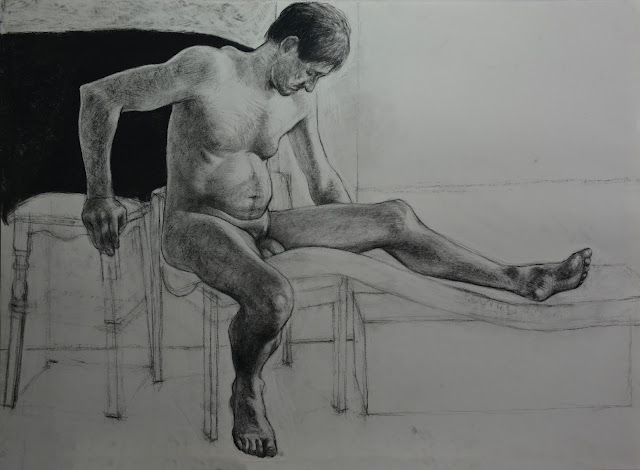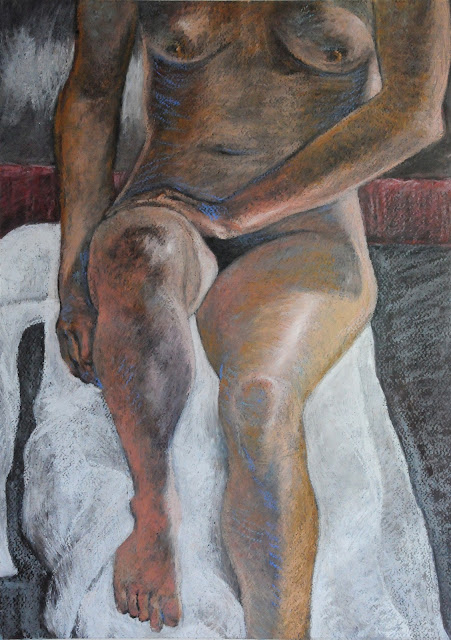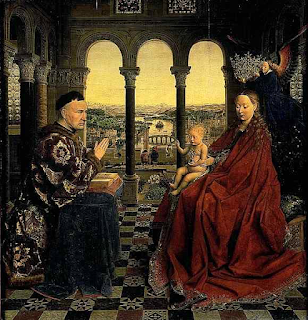Contemporary, portrait, landscape, painting, best, top ten, paintings, oil, artist, artists, gallery, life, figure, graphite, sketch, Snowdonia, drawings, pencil, Art, geometry, composition, Master, Masterpiece, Welsh, Wales, Artist, technique, poses, traditional, gallery,
'Seated male' Black conté crayon on paper.
This posting shows some of my life drawing with the figures in a sitting pose. It's strange, but when confronted by such a simple pose, there is always a moment when I think oi oi, this is a bit too obvious. But then as soon as I begin looking carefully at the subtleties of form and light, the usual absorption kicks in. This first drawing took around five hours, (broken up by lunch and other breaks - it's what we call a day-long pose), and I felt real sympathy for the model, it must have been very difficult. He earnt his money that day.
(N.b., don't forget that you can enlarge any image simply by hovering over it and clicking. Select the back arrow to return.)
'Seated female' Pencil on paper.
'Emily' Black conté crayon on paper.
The three-dimensionality on this figure is achieved largely by the tonal work on the surface of the body, (i.e., firstly applying the crayon marks and then, where necessary, 'drawing into' these marks with a plastic eraser), and always making sure that the marks follow and describe the directional flow of the surface. It always helps when we can clearly see the 'substructure', i.e., the bones and muscles of a model like this one.
'Emily' Black conté crayon on coloured paper.
A very similar pose, drawn this time with a suggestion of colour and drawn onto coloured paper. Also on A2-size paper.
'Seated female' Oil pastel on paper.
Sennelier produce a box of 20 oil pastels which are specifically chosen to describe skin tones. I've tried bigger boxes, with more wide-ranging colours, but the limited palette in this box is definitely enough for most life drawing work.
'Seated female' Black graphite on paper.
I've always been a fan of Cubism, and particularly the Analytic Cubist period. And occasionally the influence of their approach comes through in my own work. This drawing of a seated female is one I did way back in the 1960's when I was a student at St.Martins, so it shows how far back I've had this bug. The drawing is obviously not adopting their multiple viewpoints and fragmentation of the object, but I think it does emulate their intention of simplifying form and of adopting a vigorous application. In this drawing, as in most work I do, the use of the eraser is important, for example in picking out highlights and in rendering areas of tone more subtle.
'Seated male' Oil Pastel on an acrylic ground.
In this pastel drawing I was more interested in the composition than the whole figure itself, so I chose only a part of the set-up to draw. This reminds me that in life drawing it is acceptable to set one's own brief and focus on whatever is found to be interesting visually.
'Seated male' Black conté crayon on paper.
A lot of this drawing was done using the crayon held longways, i.e., applying the whole length of the crayon, rather than just the point. This method is very useful as it allows for very quick filling in of broader areas.
'Seated male' Black conté crayon on paper.
Because I spent more time on this drawing (around 5 hours on an A1 sheet) it was possible to see it as more of a portrait. And therefore the individual facial 'likeness' of the individual becomes more important than on a standard life drawing.
'Seated male' Black conté crayon on paper.
The odd touch of white chalk picks out the highlights.
'Seated male' Black conté crayon on paper.
In this work I initially drew the whole figure as a sort of stick figure, with rather vague indications of where things like joints were (see his left ankle). And after the figure was completed in this cursory way, I then started at the top left of the figure, working downwards, to put in the form more clearly. I only got about halfway when time ran out. Working from the top left to bottom right has an additional benefit for me, in that I have to (because of my shake) lean my little finger on the paper in an attempt to steady my hand, and thereby hopefully to minimise the amount of blurring in my work.
'Grumpy model' Black conté crayon on paper.
Oh dear! Obviously not a good day to be modelling.
Quentin Crisp, The Naked Civil Servant.
quiz quiz qu iz q. uiz quiz
Music
By the way, recently I've been using some of my landscapes, figure paintings and life drawings, alongside some music, in a series of YouTube videos based at
Songs From Wales.
You're very welcome to take a quick look if you have the time.
These songs can also be found on (and downloaded from) iTunes, Spotify, CDBaby, and many other platforms.
quiz quiz qu iz q. uiz quiz
. . and now, a Recommended Read . .
Any book by George Orwell is well worth reading. Along with writers like Solzhenitzyn, he is the most powerful analyst of the evils of tyranny in the 20th century. In particular he understands how the initially-seductive theories of communism (such as equality of outcome) lead, in practice, rapidly through enforcement and control to totalitarianism.Harry.
Homage to Catalonia is George Orwell's personal account of his experiences and observations fighting for the POUM militia of the Republican army during the Spanish Civil War. The war was one of the defining events of his political outlook and a significant part of what led him to write in 1946, "Every line of serious work that I have written since 1936 has been written, directly or indirectly, against totalitarianism and for Democratic Socialism, as I understand it."
Originally intending merely to report on the Spanish Civil War as a journalist, George Orwell found himself embroiled as a participant —as a member of the Workers’ Party of Marxist Unity. Fighting against the Fascists, he described in painfully vivid and occasionally comic detail life in the trenches—with a “democratic army” composed of men with no ranks, no titles, and often no weapons—and his near fatal wounding. As the politics became tangled, Orwell was pulled into a heartbreaking conflict between his own personal ideals and the complicated realities of political power struggles.
Review from Amazon.
quiz quiz qu iz q. uiz quizTo subscribe to free email notifications of my newest posts, please go to the pull-out menu (on the right side of themain screen). Select 'SUBSCRIBE' and input your email address.
When you receive the email,
you can go to the site itself by clicking on the blog title.
You can un-subscribe at any time
Homage to Catalonia is George Orwell's personal account of his experiences and observations fighting for the POUM militia of the Republican army during the Spanish Civil War. The war was one of the defining events of his political outlook and a significant part of what led him to write in 1946, "Every line of serious work that I have written since 1936 has been written, directly or indirectly, against totalitarianism and for Democratic Socialism, as I understand it."
Originally intending merely to report on the Spanish Civil War as a journalist, George Orwell found himself embroiled as a participant —as a member of the Workers’ Party of Marxist Unity. Fighting against the Fascists, he described in painfully vivid and occasionally comic detail life in the trenches—with a “democratic army” composed of men with no ranks, no titles, and often no weapons—and his near fatal wounding. As the politics became tangled, Orwell was pulled into a heartbreaking conflict between his own personal ideals and the complicated realities of political power struggles.
Review from Amazon.
When you receive the email,
you can go to the site itself by clicking on the blog title.














